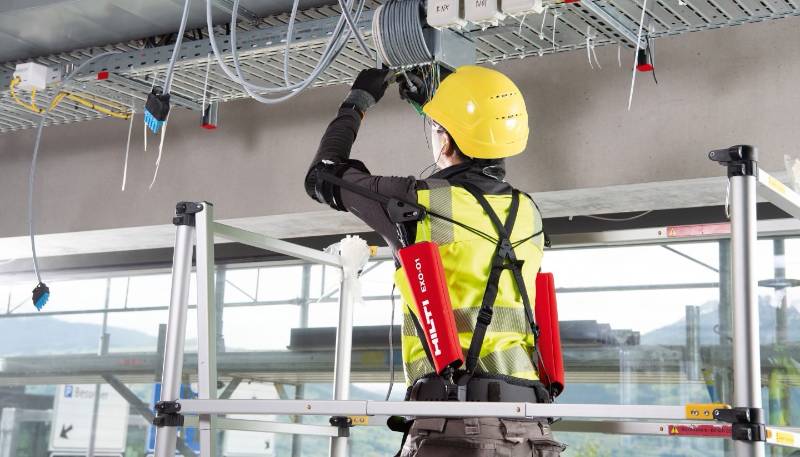Bionic Men: LSU CM, IE Professors to Design Wearable Exoskeleton
November 11, 2020
 BATON ROUGE, LA – According to the Occupational Safety and Health Administration (OSHA),
one in 10 construction site workers is injured every year, while 21% of worker fatalities
are in construction. Hoping to improve worker safety and efficiency, LSU Bert S. Turner
Department of Construction Management Assistant Professor and Graduate Coordinator
Chao Wang and LSU Professor of Industrial Engineering Fereydoun Aghazadeh are collaborating
with Rutgers University to develop an integrated, multidisciplinary approach to bring
emerging robotic technologies, such as a wearable exoskeleton, to the construction
industry that will save lives and time.
BATON ROUGE, LA – According to the Occupational Safety and Health Administration (OSHA),
one in 10 construction site workers is injured every year, while 21% of worker fatalities
are in construction. Hoping to improve worker safety and efficiency, LSU Bert S. Turner
Department of Construction Management Assistant Professor and Graduate Coordinator
Chao Wang and LSU Professor of Industrial Engineering Fereydoun Aghazadeh are collaborating
with Rutgers University to develop an integrated, multidisciplinary approach to bring
emerging robotic technologies, such as a wearable exoskeleton, to the construction
industry that will save lives and time.
Wang, Aghazadeh, and Rutgers recently received a $150,000 planning grant from the National Science Foundation as part of NSF’s 10 Big Ideas—Future of Work at the Human-Technology Frontier (FW-HTF) program to develop an exoskeleton. The award gives LSU and Rutgers one year to create a team of researchers to compete for a $3 million research grant in March. So far, their project is ahead of the game since there are few, if any, construction companies that have actually adopted exoskeleton technology.
This FW-HTF project has three goals—to develop lightweight, flexible, high-performance, personalized wearable exoskeletons for construction workers; develop machine learning-based human skill modeling and training in construction; and initiate new cross-disciplinary collaboration and foster engagement with industry partners and stakeholders.
“Construction workers get hurt for three reasons,” Aghazadeh said. “Number one, they are tired. Number two, the task is beyond their capacity. Number three, they are not properly trained. If they don’t have the capacity to do the physical work, how can we enhance their physical capability? We can give them more power. This project is all about that.”
Wang, who serves as the project’s principal investigator, says there are a few exoskeleton products currently available on the market, but they mainly target the industrial/manufacturing setting. The exoskeleton is still a new concept in construction because the construction site is more dynamic and complicated.
“We’re seeing how we can explore personalized exoskeleton or robotics technology,” Wang said. “In a manufacturing facility, a worker probably does the same thing 1,000 times a day. It’s repetitive, which is perfect for an exoskeleton because they design it just for that one task. A construction site is a lot different. You must be able to climb stairs, walk, squat, and reach out to different levels depending on what trade you are in.
“That makes it difficult to design an exoskeleton because you need something that can help with all of these tasks. We are investigating how to make the exoskeleton smart enough to recognize what task the construction worker is doing and adjust its power level and control strategy to more effectively assist with the work.”
Wang and Aghazadeh will study what tasks each construction crew member performs in order to develop and train an exoskeleton that fits different construction tasks. They will consider if the robotic exoskeleton should support the upper or lower body and how much power should be given.
“In medical and military applications, you wear a lower limb exoskeleton to prevent you from falling while giving support from the bottom,” Wang said. “However, on a construction site, when you frequently kneel or squat, you will have a lot of resistance from the exoskeleton if the power level and control strategy is not properly set. The robot must be smart enough to know what you’re trying to do and what your next move is, so it must be adjusted accordingly.”
The robotic metal framework exoskeleton would not only promote construction workers’ safety but also longevity in their job.
“With the help of robotics, these older workers can still perform,” Wang said. “That way, when younger workers come in, they can learn from the older, more experienced workers who have more knowledge that can be passed on.”
“People are living longer and longer, so society must support them so they can keep working,” Aghazadeh said.
The team says its motivation for this project comes from the workforce shortage in the United States. There are plenty of construction jobs along the Gulf Coast but not enough workers. Wang said what caused the workforce shortage is construction workers aging or retiring due to an injury and a decrease in young people doing construction work.
With an exoskeleton to alleviate risk of injury, more construction workers could perform for more years and do so safely and efficiently. The team said it would also open the door to more women being able to do jobs that were once solely for men.
There are some issues the team is trying to work out, such as the cost of the exoskeleton and how it could work safely in different weather conditions since it would be powered by battery.
“The idea down the line is that anyone can buy this in a Home Depot or Lowe’s, and they’ll come in different sizes,” Wang said. “We want one product that can be smart enough to fit anyone with different tasks.”
The team is currently collaborating with industry companies and trade schools who are not yet aware of this technology but will help them develop a better product.
“It takes industry and society working together to make this happen,” Aghazadeh said.
Like us on Facebook (@lsuengineering) or follow us on Twitter and Instagram (@lsuengineering).
###
Contact: Libby Haydel
Communications Specialist